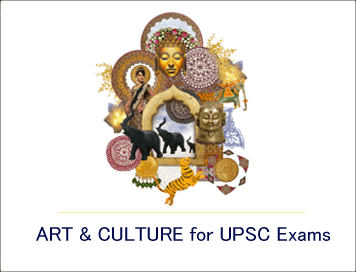(HOT) UPSC Current Affairs 2025 PDF
NEW! The Gist (NOV-2025) | E-BOOKS
Major Indian Religions : Art & Culture for UPSC Exams

Major Indian Religions : Art & Culture for UPSC Exams
MAJOR INDIAN RELIGIONS
India is the land of religions. India being a secular country does not recognise a ny religion as state religion. The Constitution allows freedom of faith, worship and religion. India is the birth place of four of the worlds major religious traditions, namely Hinduism, Jainism, Buddhism and Sikhism. The other religions in India are Christianity. Islam, Zoroastrianism, Judaism and the Bahai faith.
Hinduism:
It is believed that Hinduism was the oldest religion to come into existence in India. Almost 80% of the population follows the Hindu religion in India. Hinduism is world’s third largest religion after Christianity and Islam. Many aspects of Hindu philosophy like Yoga, Ayurvedic medicine, Vegetarianism, Karma and reincarnation have been popularized in the West by Indian Spiritual figures. Hinduism has a profound philosophy. The sacred tasks of Hindus are the Vedas, Upanishads, the Gita, the Ramayana and the Mahabharatha.
Jainism:
Jains form less than one percent of the Indian population. The states of Gujarat and Rajasthan have the highest concentration of Jain population in India. Jainism rejected the authority of the Vedas and Vedic rituals. It did not believe in the existence of God, but it believe in Karma and the transmigration of soul (Nirvana). The early Jains discarded the Sanskrit language and adopted Prakrit language.
Buddhism:
Though Buddhism originated in India, Now there is less than 1% of the India’s population 85 percent of all the Buddhists in India are concentrated in Maharashtra, Arunachal Pradesh and the higher Himalayan habitats of north western India too have some Buddhist popul a ti on. After originating in India , Buddhism spread throughout the central Asia, Sri Lanka, Tibet, China, Mongolia, Korea, Japan and Vietnam.
Sikhism:
About 2% of the total population of India form Si khs In compa ris on to ot herreligions, Sikhism is a younger religion. Sri Guru Nanak Dev started the Sikh religion He was the first Guru of the Sikhs. Sikhism which emerged in the 15th Century tried to bridge the gap between Hinduism and Islam.Though Sikhism is dispersed widely over the entire India , their largest concentration is in Punjab, where they form the majority of the state’s population.
Islam:
The second most dominant religion after Hinduism is Islam. In India, about 12% of the population follows the Islam religion. Though spread all over all parts of India. The ratio of Muslim population exceeds the national average in Lakshadweep Islands, Jammu and Kashmir, Assam and West Bengal. Though the Muslims form only 12 percent of the total population of India, the influence of Islam on Indian society is much stronger. The Muslim population in India is the third largest in the world.The shrines of some of the most famous saints of sufism like Moinuddin Chishti and Nizamuddin Auliya are in India. India is a ls o home to s ome of t he mos t famous monuments of Islamic architecture like the Taj Mahal and the Qutab Minar.
BAHA’I FAITH
Bahai’s are from various parts of the world. The Baha’i Faith is the youngest of the world’s independent religion. India was the 6th country to have the Baha’i Faith introduced to it. Baha’i Faith in India is numerically small and tiny in proportion of the national population. The Baha’i House of worship in Delhi, popularly known as the Lotus Temple is a prominent attraction in Delhi. It was completed in 1986 and serves as the mother temple of the Indian subcontinent
Christianity:
Christianity is the third most dominant religion in India. At present there are about 2.3percent Christians in India .They are highly concentrated in Goa, Maharashtra, Arunachal Pradesh, Tamil Nadu and Kerala.
Zoroastrianism:
Zoroastrianism have an ancient history in India. Though the total number of Zoroastrains (Parsis) in Indian population is very less yet they continue to be one of the important religious communities of India. According to 2001 census, there are about 70,000 Parsis in India. Most of them live in Mumbai and the rest in Gujarat
Judaism:
Indian Jews are a religious minority of India. Judaism was one of the first foreign religions to arrive in India. According to the 1991 census there were about 5,271 Jews in India. Of the total Jewish population in India about half live in Manipur and Mizoram and a quarter live in the city of Mumbai. In Kerala a community of Jews are seen in the cities of Kannur (Kodungalloor) and Kochi.
